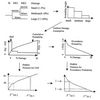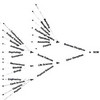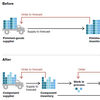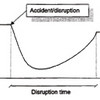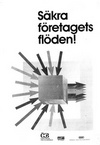
This is the final part of my translation of the Swedish book “Säkra företagets flöden”, published in 1999 by the Swedish Emergency Management Agency. Although 10 years hold, much of this handbook still holds true. This article takes a closer look at suppliers, and the current development towards more and more specialized components and tailor-made systems, where the supplier becomes maybe more important than the purchasing company.
Suppliers – no longer just suppliers
There was a time when a supplier really was a supplier. Of unrefined raw materials, that is. Raw materials that were used in the manufacturing process of a company to create a finished product. Today, more often than not, this is no longer the case. Raw materials have turned into semi-finished products, independent components or whole systems that are assembled on order and on customer specifications, not specifications set by the company/producer.
Categories of incoming raw materials
Raw materials can be roughly divided into four categories along these: two axes: Standardized > Specialized, Single/separate components > Systems.
- Standardized, single components – To put it very simple, nuts and bolts you can buy in any store or from any supplier.
- Specialized, single components – Semi-finished and made-to-fit components that are assembled in a certain manner by the manufacturer.
- Standardized system – Made-to-fit components that are assembled by the supplier in a certain manner to form a working system. The supplier rather than the producer sees the market needs or producer needs.
- Specialized system – A cooperation between supplier and producer to design a whole system, often based on end customer specifications.
Have you asked yourself these questions?
- How dependent is our company on certain (kinds of) raw materials?
- Do we have an inventory policy? is is thought-through?
- What are our options for substituting our most important raw materials?
- How diversified are our suppliers?
- Do we have long-term contracts with our suppliers?
- How globally concentrated are our supplies? Do they come from the same region/area?
- What are our experiences with regard to supply disruptions?
- Are we monitoring the political situation in important supplier countries?
How to chose the right supplier
There are many factors that will influence a company’s choice of supplier, most importantly is the suppliers importance for the company’s core business and future development. Some factors that should be considered are (in random order):
- Quality
- Research and development
- Reliability
- Flexibility
- International (export) experience
- Leadership/management
- Price
- Logistics
- Size
- Productivity/ solidity
- Customer service
Increased integration – increased vulnerability
One of the pitfalls is the integration of a supplier into a lean production or just-in-time supply chain without being fully aware of the possible consequences in case of disruptions. That said, there’s nothing wrong with applying lean production or just-in-time, as long as you are aware of the what this entails and what requirements your suppliers must meet in order to fulfill your production needs.
How to protect yourself from disruptions
Unfortunately, there are no shortcuts or one-solution-fits-all way of dealing with supply chain disruption. Nonetheless, four directions are possible:
Stockpiling/inventory – This can be either at your production facilities or with the supplier. Mind the cost, though.
Alternative suppliers – This is possible, but if you are delivering specialized systems, rather than standardized products this may not be an option at all.
Standardization – Keep it simple, stupid. Does our specialized system need to be made of specialized components? Can we use standard components, but rather arrange them in a special manner?
Quality – Quality means quality in all parts of the supply chain. Total quality as far back (and forward) as possible is one of the best guarantors against supply chain disruptions.
Reference
Giertz, E., et al. (1999) Säkra företagets flöden, Silfgruppen, Stockholm. ISBN 91 7097 056-4
Related
- husdal.com: How to secure your supply chain – 1/7
- husdal.com: How to secure your supply chain – 2/7
- husdal.com: How to secure your supply chain – 3/7
- husdal.com: How to secure your supply chain – 4/7
- husdal.com: How to secure your supply chain – 5/7
- husdal.com: How to secure your supply chain – 6/7
- husdal.com: How to secure your supply chain – 7/7

